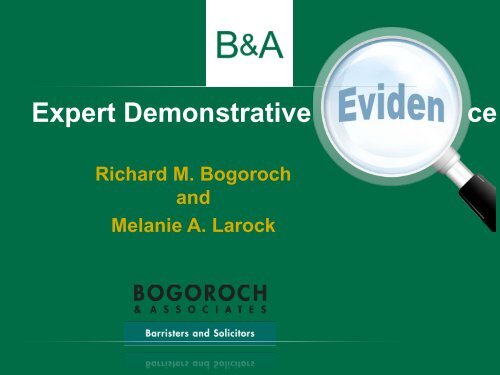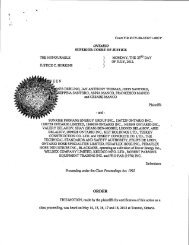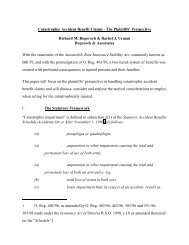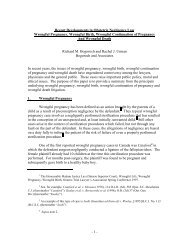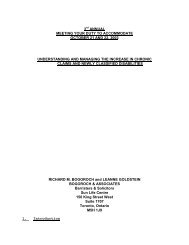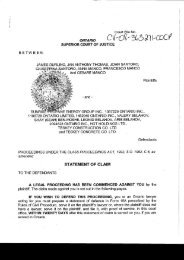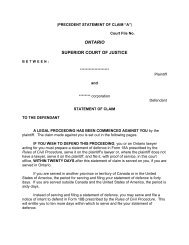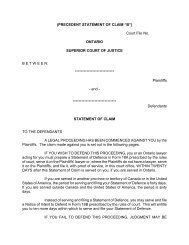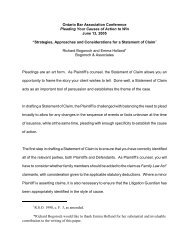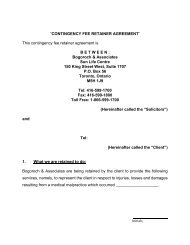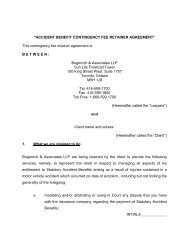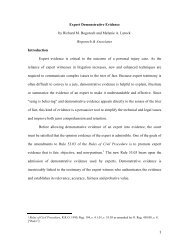Expert Demonstrative Evidence - Bogoroch & Associates
Expert Demonstrative Evidence - Bogoroch & Associates
Expert Demonstrative Evidence - Bogoroch & Associates
Create successful ePaper yourself
Turn your PDF publications into a flip-book with our unique Google optimized e-Paper software.
<strong>Expert</strong> <strong>Demonstrative</strong><br />
ce<br />
Richard M. <strong>Bogoroch</strong><br />
and<br />
Melanie A. Larock
<strong>Demonstrative</strong> <strong>Evidence</strong> is essential to:<br />
• Explain<br />
• Illustrate<br />
• Summarize<br />
page 2
<strong>Demonstrative</strong> <strong>Evidence</strong> is essential to:<br />
• Simplify technical / legal issues<br />
• Improve juror comprehension / retention<br />
page 3
<strong>Demonstrative</strong> <strong>Evidence</strong><br />
Amendments to Rule 53.03<br />
Rules of Civil Procedure<br />
Promote expert evidence that is fair,<br />
objective, and non-partisan<br />
page 4
Admissibility of <strong>Demonstrative</strong> <strong>Evidence</strong><br />
Completely within the discretion of the trial judge<br />
page 5
Admissibility of <strong>Demonstrative</strong> <strong>Evidence</strong><br />
• Relevant<br />
• Accurate and fair<br />
• Probative value must outweigh prejudicial effect<br />
• Must not offend any exclusionary rule<br />
• Be of assistance to the court<br />
page 6
Admissibility of <strong>Demonstrative</strong> <strong>Evidence</strong><br />
Admissible UNLESS:<br />
• Caught by exclusionary rule<br />
• Prejudicial effect outweighs probative value<br />
page 7
Admissibility of <strong>Demonstrative</strong> <strong>Evidence</strong><br />
Sopinka, Lederman & Bryant:<br />
The Law of <strong>Evidence</strong> in Canada, 3 rd ed.<br />
(Markham: Lexis Nexis, 2009, authors Bryant,<br />
Lederman, Letterman & Fuerst , s. 12.126<br />
page 8
Admissibility of <strong>Demonstrative</strong> <strong>Evidence</strong><br />
To be admissible,<br />
the expert evidence that it exists to explain and<br />
illustrate must also be admissible<br />
page 9
Admissibility of <strong>Demonstrative</strong> <strong>Evidence</strong><br />
Supreme Court of Canada<br />
R. v. Mohan (1994), 114 D.L.R. (4 th ) 419<br />
Pre-conditions for admission of expert evidence:<br />
• Relevance<br />
• Necessity in assisting the trier of fact<br />
• Absence of any exclusionary rule<br />
• Properly qualified expert<br />
page 10
Admissibility of <strong>Demonstrative</strong> <strong>Evidence</strong><br />
R. v. Abbey, [2009] O.J. No. 3534<br />
• evidence must meet 4 prerequisites of admissibility of<br />
expert evidence as identified in R. v. Mohan<br />
• trial judge must determine that expert evidence<br />
is beneficial to the trial process<br />
page 11
<strong>Demonstrative</strong> <strong>Evidence</strong><br />
Rule 53.03<br />
Requirements for expert report:<br />
a. <strong>Expert</strong>’s name, address, area of expertise<br />
b. <strong>Expert</strong>’s qualifications, employment, educational<br />
experiences<br />
c. Instructions provided to the expert<br />
d. Nature of opinion being sought<br />
e. <strong>Expert</strong>’s opinion respecting each issue<br />
f. <strong>Expert</strong>’s reasons for his/her opinion<br />
g. Acknowledgement of expert’s duty under Rule 4.1<br />
signed by expert<br />
page 12
<strong>Demonstrative</strong> <strong>Evidence</strong><br />
• Probative potential of evidence<br />
• Significance of issue to which evidence is directed<br />
page 13
<strong>Demonstrative</strong> <strong>Evidence</strong><br />
Reliability Concerns:<br />
• Subject matter of evidence<br />
• Methodology used by expert in arriving at opinion<br />
• <strong>Expert</strong>’s expertise<br />
• Language used in explaining opinion<br />
• Extent of impartiality / objectivity<br />
page 14
<strong>Demonstrative</strong> <strong>Evidence</strong><br />
Risks<br />
“consumption of time, prejudice and confusion”<br />
Binnie J. in J.-L.J., para. 47<br />
page 15
<strong>Demonstrative</strong> <strong>Evidence</strong><br />
McCormick on <strong>Evidence</strong>, (5 th ) ed.,<br />
Volume 2 at pp. 17-19<br />
page 16
page 17
Photographs/Videotapes<br />
page 18
Cost Benefit Analysis<br />
<strong>Expert</strong><br />
Opinion<br />
page 19
Cost Benefit Analysis<br />
<strong>Expert</strong><br />
Opinion<br />
page 20
Cost Benefit Analysis<br />
<strong>Expert</strong><br />
Opinion<br />
page 21
<strong>Demonstrative</strong> <strong>Evidence</strong><br />
Jenkyns v. Kassam (2006), Carswell Ont. 8890 (S.C.J.)<br />
• <strong>Expert</strong>’s testimony is relevant and admissible;<br />
demonstrative aid relates to evidence<br />
• <strong>Expert</strong> whose testimony the demonstrative aid depicts is<br />
familiar with it<br />
• <strong>Demonstrative</strong> aid fairly and accurately reflects expert’s<br />
evidence<br />
• <strong>Demonstrative</strong> aid will aid<br />
trier of fact<br />
page 22
Integrity of <strong>Evidence</strong><br />
The introduction of demonstrative evidence must be<br />
done in a manner that will ensure the integrity of the<br />
evidence so tendered.<br />
Greer (Litigation Guardian of) v. Kurtz, [2008]<br />
O.J. No. 2925 at para. 10.<br />
page 23
Integrity of <strong>Evidence</strong><br />
Accurate?<br />
Fair?<br />
page 24
Integrity of <strong>Evidence</strong><br />
page 25
Integrity of <strong>Evidence</strong><br />
Admissibility of computer-generated<br />
reconstruction animation<br />
Owens (Litigation Guardian of)<br />
v. Grandell [1994] O.J. No. 496,<br />
46 A.C.W.S. (3d) 796 (Gen. Div.)<br />
page 26
Admissibility<br />
Computer-generated reconstruction animation<br />
• Testimony from A.R. expert: data points measured at accident<br />
were accurate<br />
• Testimony from data entry person: data entered correctly<br />
• Algorithms used in form and motion software:<br />
» Validly apply law of physics<br />
» Validly render accurate images of scenes depicted<br />
page 27
Admissibility<br />
Computer-generated reconstruction animation<br />
• Testimony from A.R. expert: additional modifications to exhibit<br />
after first renderings are valid<br />
• Testimony from experts that they are familiar with demonstrative<br />
exhibit<br />
• Exhibit will aid the trier of fact in understanding testimony<br />
page 28
Admissibility<br />
Lancaster (Litigation Guardian of) v. Santos,<br />
[2011] O.J. No. 3706<br />
• Engineer’s calculations not provided to court<br />
• Data not proven reliable or accurate<br />
page 29
Admissibility<br />
Greer (Litigation Guardian of) v. Kurtz<br />
• Both reconstruction engineer / forensic animator testified to<br />
accuracy of animations<br />
Justice B.H. Matheson: “all the safeguards had been met.”<br />
page 30
Guidelines<br />
Uses and Abuses of <strong>Demonstrative</strong> <strong>Evidence</strong><br />
(Geoffrey D.E. Adair)<br />
• Place reasonable limit on number of demonstrative aids<br />
employed<br />
• Avoid undue use of aids<br />
• Use professional looking aids<br />
• Employ sign-message demonstrative aids<br />
• Use in the natural flow of the case<br />
• Make copies of visual material available<br />
• Use only where truly<br />
effective<br />
page 31
Conclusion<br />
<strong>Demonstrative</strong> <strong>Evidence</strong><br />
• Persuasive<br />
• Simplifies complex subjects<br />
• Memorable<br />
• Reduces boredom / renews interest<br />
• Enhances ability to come to conclusion<br />
page 32
Appendix<br />
Forms of <strong>Demonstrative</strong><br />
<strong>Evidence</strong>
Photographs<br />
Draper v. Jacklyn (1970), 9 D.L.R. (3d) 264 (S.C.C.):<br />
Photographs may be admitted if:<br />
1. they are relevant;<br />
2. they assist the jury’s understanding<br />
of the treatment and condition of the<br />
plaintiff;<br />
page 34
Photographs<br />
Draper v. Jacklyn (1970), 9 D.L.R. (3d) 264 (S.C.C.):<br />
Photographs may be admitted if:<br />
3. the photographs are accurate; and<br />
4. the prejudicial effect of the<br />
photographs is not so great that<br />
it would exceed the probative value<br />
page 35
Video Tapes<br />
Teno v. Arnold (1974), 7 O.R. (2d) 276:<br />
“day in the life” video<br />
The test to be applied in considering the admission<br />
of videotape and photographs is the same:<br />
Rodger v. Strop (1992), 14 C.P.C. (3d) 289.<br />
page 36
Video Tapes<br />
R. v. Nikolovski (1994), 19 O.R. (3d) 676 (Ont. C.A.)<br />
approved following test for admissibility of video tapes:<br />
1. the accuracy of the tapes in truly<br />
representing the facts<br />
2. their fairness and absence of intention<br />
to mislead; and<br />
3. their verification on oath by a person<br />
capable of doing so<br />
page 37
Treatment Chronologies<br />
Calic v. Aitchison et al, [1996] O.J. No. 154 (Gen. Div.).<br />
Justice Hockin stated, “Mr. Calic’s medical history since the<br />
accident is lengthy and complicated. Counsel for Mr. Calic<br />
usefully summarized the history by tracing Mr. Calic’s five<br />
year journey from one specialist to another in documentary<br />
form (Exhibit 5).”<br />
page 38
Computer Generated Animations<br />
Owens v. Grandell, [1994] O.J. No. 496 (see above)<br />
McCutcheon v. Chrysler Canada Ltd., [1998] O.J. No. 5818<br />
stated criteria for admissibility:<br />
1. the computer animation is relevant to the issues in the<br />
proceeding;<br />
2. the hardware and software methods employed by the<br />
animator are verified by the animator;<br />
page 39
Computer Generated Animations<br />
3. the computer animation does not contain editorial<br />
comments other than the usual headings;<br />
4. the computer animation accurately represents the<br />
plaintiff’s condition;<br />
5. the computer animation is necessary considering that it<br />
would be difficult for a witness to describe the effects of<br />
the injury and the jury’s understanding of the issues<br />
would be greatly assisted by the animation;<br />
page 40
Computer Generated Animations<br />
6. the prejudicial value does not outweigh the probative<br />
value considering that the animation is presented in a<br />
way very simple straightforward manner, without sound<br />
or editorializing and with few headings; and<br />
7. the presentation was not misleading or unfair to the<br />
defendant.<br />
page 41
Computer Generated Animations<br />
Cejvan v. Blue Mountain Resorts Limited, [2008]<br />
O.J. No. 5443:<br />
Three-dimensional computer model of the ski run used by<br />
the plaintiff.<br />
The animation was accepted only for the limited purpose of<br />
showing the general topography of the area.<br />
L.C. Templeton J. was critical of the animation because it<br />
lacked accuracy, relied upon too many unknown factors<br />
and was prejudicial.<br />
page 42
Anatomical Illustrations or Models<br />
Majencic v. Natale, [1968] 1 O.R. 189 (H.C.J.)<br />
Jenkyns v. Kassam, [2006] O.J. No. 5494<br />
page 43
Power Point Presentations<br />
R. v. Sandham (2009), Carswell Ont 6592 (S.C.J.):<br />
admissible<br />
R. v. Paul (2004), Carswell Ont 1256: inadmissible<br />
page 44


